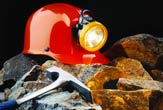The Technologies That Will Save the Trapped Chilean Miners

As the plight of the trapped miners in Chile wears on, rescuers will rely on a number of technologies to keep the 33 men alive until they can be freed from nearly half a mile down – a process that could take several months.
These technologies, from precision drilling to customized sustenance delivery tubes, have evolved to aid in some of the world's most difficult rescues.
As with other mining disasters, locating anyone entombed in the mine in Copiapo posed the first challenge for rescuers.
After another cave-in blocked a ventilation shaft, the only option rescue workers had for reaching the missing mining team was to drill six-inch (15-centimeter) exploratory holes deep into the ground.
Attempts to reach an underground shelter where the miners might have sought refuge failed seven times – blamed on the mining company's poor maps – but the eighth try finally reached the sanctuary at a depth of 2,257 feet, according to MSNBC.
Drilling straight down over hundreds of feet can be tricky business, according to Jeffery Kravitz, a U.S. Mine Health and Safety Administration (MHSA) technical expert. After all, drilling just a single degree off of a straight line (perpendicular to the surface) to a target can leave one more than 40 feet off-base.
To precisely drill where intended, specialist companies do "downhole surveying" with equipment such as gyroscopes and magnetic inclinometers.
Get the world’s most fascinating discoveries delivered straight to your inbox.
Kravitz does not know what equipment the Chilean rescuers have handy, but he is impressed with how they have dropped two, and now three, bore holes almost next to each other into the shelter to deliver food and air.
"They must have been very confident drillers to put two holes right into that mine at such large depths," Kravitz said. "They knew their stuff."
[Read also "Next Gen Mining Safety Tech Saves Lives with Advanced Sensors."]
Lowering aid in
Once bore holes are dug, rescuers typically lower imaging and communications equipment such as TV cameras and microphones to gather situational information and – if there are survivors – establish personal links, Kravitz said.
Chilean rescuers on Monday started sending down five-foot- (1.5-meter-) long tubes called palomas, or "doves" in Spanish. Rescuers packed the tubes with rehydration tablets and a high-energy glucose serum to nourish the miners' starved and fragile digestive systems, MSNBC reported.
Kravitz said rescue workers in the United States have crafted similar tubes out of steel and plastic as they improvised on the site, depending on the size of the emergency bore holes.
News reports also indicate that a long hose was used to line the bore holes with a "metallic gel" to reinforce them and lubricate the passage of the palomas. Kravitz said he has not heard of this technique, though a hardening material such as Gunnite, which sees service in shoring up weak walls in mines, might get the job done.
Mine workers often "case" straight up-and-down bore holes in the U.S., meaning they insert steel piping down the shafts to insure them against crumbling and to provide a smooth delivery canal to people below.
Light at the end of the runnel
A large drilling machine, donated by Codelco copper company in Chile, will soon begin drilling the 26-inch hole through which the trapped miners will be hauled back to the surface. Kravitz believes this rig to be a rotary-type drill, meaning its drill rotates with several diamond-tipped, teeth-like "bits" that chew up the rock underneath. Chilean estimates that drilling this rescue hole will take several months seem reasonable, Kravitz said.
When the rescue drill finally reaches the malnourished miners months hence, the final obstacle will be actually hoisting them out.
Media depictions of this and other mining accidents have shown the relieved miners strapped into a harness-like device. Though this might well happen and has been done in mine rescues before, Kravitz said, the procedure is a bit risky.
Cracks and cavities that might form along the narrow escape tunnel can snag an arm or a leg and injure the miner, Kravitz noted.
Miners pulled out of pits typically point their hands skyward, Kravitz said, in effect raising their shoulders to reduce the space taken up by their bodies.
In the United States, MHSA protocol calls for deploying a "rescue capsule" that trapped miners can squeeze into and then be raised to the surface.
This 21.5-inch (54.6-centimeter) diameter capsule saw its first and so far only use in 2002 at the Quecreek mining incident in Pennsylvania. Rescuers pulled all nine miners out of the flooding coal mine with the yellow-painted metal cage.
MHSA keeps the capsule in its West Virginia facility and could in theory airlift it to the collapsed Chilean mine well before rescuers finish boring an escape route, though it is intended for use in a cased bore hole.
As in many situations, technology will only get one so far. Surviving in a hot, humid subterranean cavern will largely come down to personal grit and collective cooperation.
Fortunately, miners are well-accustomed to extreme conditions that might make many of us despair.
"If anybody in the world can survive for four months’ underground," Kravitz said, "it's miners."
• Next Gen Mining Safety Tech Saves Lives with Advanced Sensors • New Law Puts 'Conflict Minerals' for Gadgets in the Spotlight • 7 Gadgets That Changed the World



